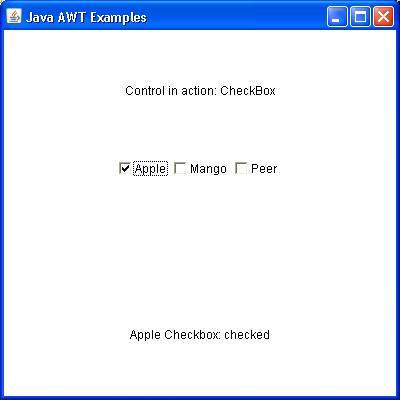
- AWT Tutorial
- AWT - Home
- AWT - Overview
- AWT - Environment
- AWT - Controls
- AWT - Event Handling
- AWT - Event Classes
- AWT - Event Listeners
- AWT - Event Adapters
- AWT - Layouts
- AWT - Containers
- AWT - Menu
- AWT - Graphics
- AWT Useful Resources
- AWT - Quick Guide
- AWT - Useful Resources
- AWT - discussion
AWT CheckBox Class
Introduction
Checkbox control is used to turn an option on(true) or off(false). There is label for each checkbox representing what the checkbox does.The state of a checkbox can be changed by clicking on it.
Class declaration
Following is the declaration for java.awt.Checkbox class:
public class Checkbox
extends Component
implements ItemSelectable,Accessible
Class constructors
| S.N. | Constructor & Description |
|---|---|
| 1 | Checkbox() Creates a check box with an empty string for its label. |
| 2 | Checkbox(String label) Creates a check box with the specified label. |
| 3 | Checkbox(String label, boolean state) Creates a check box with the specified label and sets the specified state. |
| 4 | Checkbox(String label, boolean state, CheckboxGroup group) Constructs a Checkbox with the specified label, set to the specified state, and in the specified check box group. |
| 5 | Checkbox(String label, CheckboxGroup group, boolean state) Creates a check box with the specified label, in the specified check box group, and set to the specified state. |
Class methods
| S.N. | Method & Description |
|---|---|
| 1 | void addItemListener(ItemListener l) Adds the specified item listener to receive item events from this check box. |
| 2 | void addNotify() Creates the peer of the Checkbox. |
| 3 | AccessibleContext getAccessibleContext() Gets the AccessibleContext associated with this Checkbox. |
| 4 | CheckboxGroup getCheckboxGroup() Determines this check box's group. |
| 5 | ItemListener[] getItemListeners() Returns an array of all the item listeners registered on this checkbox. |
| 6 | String getLabel() Gets the label of this check box. |
| 7 | <T extends EventListener>T[] getListeners(Class<T> listenerType) Returns an array of all the objects currently registered as FooListeners upon this Checkbox. |
| 8 | Object[] getSelectedObjects() Returns an array (length 1) containing the checkbox label or null if the checkbox is not selected. |
| 9 | boolean getState() Determines whether this check box is in the on or off state. |
| 10 | protected String paramString() Returns a string representing the state of this Checkbox. |
| 11 | protected void processEvent(AWTEvent e) Processes events on this check box. |
| 12 | protected void processItemEvent(ItemEvent e) Processes item events occurring on this check box by dispatching them to any registered ItemListener objects. |
| 13 | void removeItemListener(ItemListener l) Removes the specified item listener so that the item listener no longer receives item events from this check box. |
| 14 | void setCheckboxGroup(CheckboxGroup g) Sets this check box's group to the specified check box group. |
| 15 | void setLabel(String label) Sets this check box's label to be the string argument. |
| 16 | void setState(boolean state) Sets the state of this check box to the specified state. |
Methods inherited
This class inherits methods from the following classes:
java.awt.Component
java.lang.Object
CheckBox Example
Create the following java program using any editor of your choice in say D:/ > AWT > com > tutorialspoint > gui >
AwtControlDemo.java
package com.tutorialspoint.gui;
import java.awt.*;
import java.awt.event.*;
public class AwtControlDemo {
private Frame mainFrame;
private Label headerLabel;
private Label statusLabel;
private Panel controlPanel;
public AwtControlDemo(){
prepareGUI();
}
public static void main(String[] args){
AwtControlDemo awtControlDemo = new AwtControlDemo();
awtControlDemo.showCheckBoxDemo();
}
private void prepareGUI(){
mainFrame = new Frame("Java AWT Examples");
mainFrame.setSize(400,400);
mainFrame.setLayout(new GridLayout(3, 1));
mainFrame.addWindowListener(new WindowAdapter() {
public void windowClosing(WindowEvent windowEvent){
System.exit(0);
}
});
headerLabel = new Label();
headerLabel.setAlignment(Label.CENTER);
statusLabel = new Label();
statusLabel.setAlignment(Label.CENTER);
statusLabel.setSize(350,100);
controlPanel = new Panel();
controlPanel.setLayout(new FlowLayout());
mainFrame.add(headerLabel);
mainFrame.add(controlPanel);
mainFrame.add(statusLabel);
mainFrame.setVisible(true);
}
private void showCheckBoxDemo(){
headerLabel.setText("Control in action: CheckBox");
Checkbox chkApple = new Checkbox("Apple");
Checkbox chkMango = new Checkbox("Mango");
Checkbox chkPeer = new Checkbox("Peer");
chkApple.addItemListener(new ItemListener() {
public void itemStateChanged(ItemEvent e) {
statusLabel.setText("Apple Checkbox: "
+ (e.getStateChange()==1?"checked":"unchecked"));
}
});
chkMango.addItemListener(new ItemListener() {
public void itemStateChanged(ItemEvent e) {
statusLabel.setText("Mango Checkbox: "
+ (e.getStateChange()==1?"checked":"unchecked"));
}
});
chkPeer.addItemListener(new ItemListener() {
public void itemStateChanged(ItemEvent e) {
statusLabel.setText("Peer Checkbox: "
+ (e.getStateChange()==1?"checked":"unchecked"));
}
});
controlPanel.add(chkApple);
controlPanel.add(chkMango);
controlPanel.add(chkPeer);
mainFrame.setVisible(true);
}
}
Compile the program using command prompt. Go to D:/ > AWT and type the following command.
D:\AWT>javac com\tutorialspoint\gui\AwtControlDemo.java
If no error comes that means compilation is successful. Run the program using following command.
D:\AWT>java com.tutorialspoint.gui.AwtControlDemo
Verify the following output
